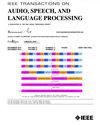二阶优化凸矩阵函数和稀疏协方差聚类方法
IEEE Transactions on Audio Speech and Language Processing
Pub Date : 2013-11-01
DOI:10.1109/TASL.2013.2263142
引用次数: 3
摘要
最近,人们提出了各种一阶方法来解决机器学习中出现的矩阵优化问题。使用这种算法的前提是二阶信息的使用成本太高,因此简单的一阶迭代可能是最优的。在本文中,我们认为二阶信息在许多矩阵优化问题中实际上是可有效访问的,并且可以有效地纳入优化算法。我们首先回顾了如何在一类广泛的矩阵优化问题中方便地表示某些Hessian操作,并为这些结果提供了第一个证明。接下来我们考虑一个具体的问题,即最小化1正则化Jeffreys散度,并推导出计算Hessians和Hessian向量积的公式。这允许我们提出各种二阶方法来解决杰弗里斯散度问题。我们给出了大量的数值结果来说明算法的行为,并将这些方法应用于语音识别问题。我们压缩了用于自动语音识别声学模型的全协方差高斯混合模型。通过发现(稀疏逆)协方差矩阵簇,我们可以将协方差参数的数量压缩超过200个因子,同时仍然优于协方差参数比原始声学模型少20倍的对角协方差模型的单词错误率(WER)性能。本文章由计算机程序翻译,如有差异,请以英文原文为准。
Second Order Methods for Optimizing Convex Matrix Functions and Sparse Covariance Clustering
A variety of first-order methods have recently been proposed for solving matrix optimization problems arising in machine learning. The premise for utilizing such algorithms is that second order information is too expensive to employ, and so simple first-order iterations are likely to be optimal. In this paper, we argue that second-order information is in fact efficiently accessible in many matrix optimization problems, and can be effectively incorporated into optimization algorithms. We begin by reviewing how certain Hessian operations can be conveniently represented in a wide class of matrix optimization problems, and provide the first proofs for these results. Next we consider a concrete problem, namely the minimization of the ℓ1 regularized Jeffreys divergence, and derive formulae for computing Hessians and Hessian vector products. This allows us to propose various second order methods for solving the Jeffreys divergence problem. We present extensive numerical results illustrating the behavior of the algorithms and apply the methods to a speech recognition problem. We compress full covariance Gaussian mixture models utilized for acoustic models in automatic speech recognition. By discovering clusters of (sparse inverse) covariance matrices, we can compress the number of covariance parameters by a factor exceeding 200, while still outperforming the word error rate (WER) performance of a diagonal covariance model that has 20 times less covariance parameters than the original acoustic model.
求助全文
通过发布文献求助,成功后即可免费获取论文全文。
去求助
来源期刊
自引率
0.00%
发文量
0
审稿时长
24.0 months
期刊介绍:
The IEEE Transactions on Audio, Speech and Language Processing covers the sciences, technologies and applications relating to the analysis, coding, enhancement, recognition and synthesis of audio, music, speech and language. In particular, audio processing also covers auditory modeling, acoustic modeling and source separation. Speech processing also covers speech production and perception, adaptation, lexical modeling and speaker recognition. Language processing also covers spoken language understanding, translation, summarization, mining, general language modeling, as well as spoken dialog systems.

 求助内容:
求助内容: 应助结果提醒方式:
应助结果提醒方式:


